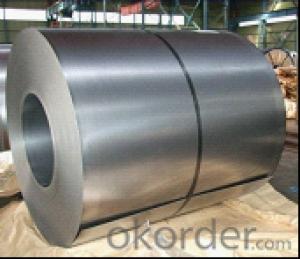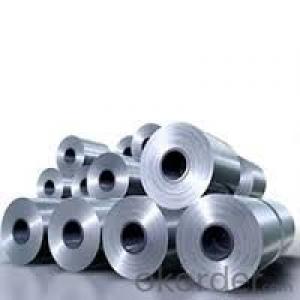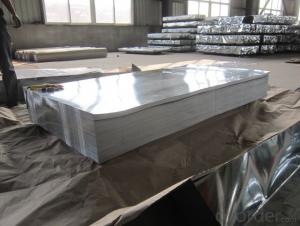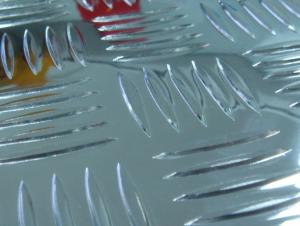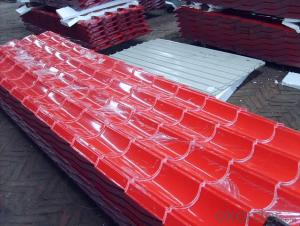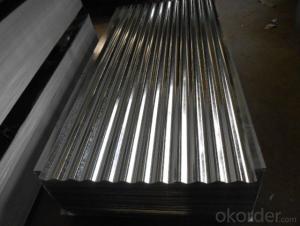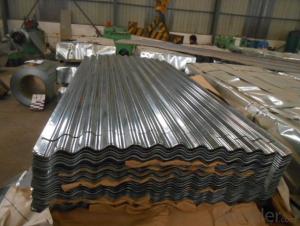Corrugated Hot-Dipped Galvanized Steel-Sheets
- Loading Port:
- Tianjin
- Payment Terms:
- TT OR LC
- Min Order Qty:
- 50 m.t.
- Supply Capability:
- 2000 m.t./month
OKorder Service Pledge
OKorder Financial Service
You Might Also Like
Description:
Pressing steel panel with the clear line, and many colors for choice, suitable for any different building style materials, achieving satisfy effects;
Pressing steel panel can be freely incised, it can satisfy the especially designing demands. It apply on convenient construction, and anti-seismic performance, fire proof, waterproof, free of maintenance, ect.
Base sheet : galvanized steel sheet, pre painted galvanized steel sheet
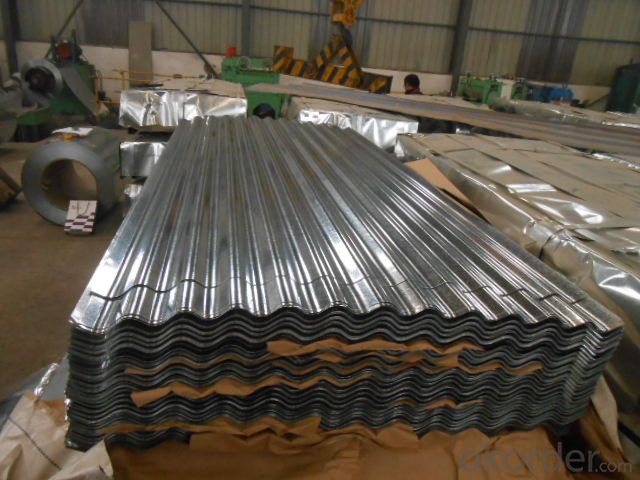
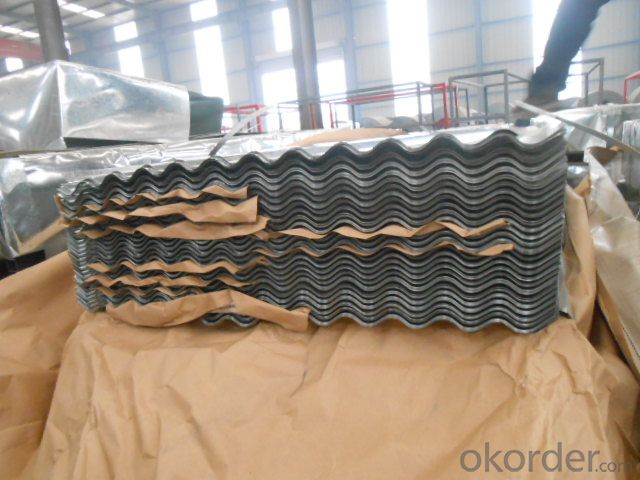
Application:
Roofing and walling, curved profiles, corrugated sheets, foamed sandwich panels for roofing and walling, roof tills, rainwater gutter, metal doors, garage doors, wall panels for partitions, ceiling panels, suspended frames, interior metal doors or windows, profiles for exterior cabinets of white appliances, office furniture, home appliances, etc.
Product Specification:
1) Standards: JIS G3302 1998 or ASTM A653M / A924M 1998
2) With excellent weather resistance
3) Suitable for partitions, vending machinery, decks, scaffolding, purlin, gurdrail, suspension bar for ceiling and so on
4) Specification: SPCC, SGCC, SGCH, SGCD, SGHC, (CS, SS, DDS)
5) Thickness: 0.14mm-50mm
6) Width: 20mm - 1250mm
7) Zinc coating: Z08, Z12, Z18, Z20, Z22, Z25, Z27.Z100 Z275
8) Surface finish: Regular spangle, minimized spangle, zero spangle
9) Surface treatment: Chromating treatment, anti-finger print
10) Inner diameter: 508mm / 610mm
11) Outer diameter: 2, 000mm max .
Package:Standard seaworthy export packing: 3 layers of packing, inside is kraft paper,water plastic film is in the middle and outside GI steel ,sheet to be covered by steel strips with lock.
FAQ:
1.How many pieces for one package?
The pieces for one tone is decided by the thickness of the sheet, but we can make it according to your requirements in the reasonable range.
2. Do you have pallets for the package?
Yes, we must use pallets for the package in order to load.
3. Could you produce the sheets according to our design?
Yes, we can.
- Q: Can steel sheets be formed into complex shapes?
- Yes, steel sheets can be formed into complex shapes through various processes such as bending, rolling, and pressing.
- Q: How do steel sheets compare to glass sheets?
- Steel sheets and glass sheets have distinct characteristics that make them suitable for different applications. Firstly, steel sheets are known for their strength and durability. They can withstand heavy loads and are highly resistant to impact and damage. This makes them ideal for construction purposes, such as in the manufacturing of buildings, bridges, and machinery. Additionally, steel sheets offer excellent protection against fire and extreme weather conditions. On the other hand, glass sheets are valued for their transparency and aesthetic appeal. They allow natural light to pass through, creating a bright and open atmosphere. Glass sheets are commonly used in windows, doors, and architectural structures to provide visibility and enhance the visual appeal of a space. Furthermore, glass sheets offer excellent thermal insulation properties, which can help reduce energy consumption in buildings. In terms of maintenance, steel sheets require minimal upkeep as they are resistant to corrosion and do not require regular cleaning. However, they may require painting or protective coatings to prevent rusting. On the contrary, glass sheets may need regular cleaning to maintain their transparency and appearance. They are also more prone to scratching and breakage compared to steel sheets. Lastly, cost is an important factor to consider. Steel sheets typically have a lower initial cost compared to glass sheets. However, the overall cost may vary depending on factors such as size, thickness, and quality. Additionally, the cost of installation and maintenance should also be taken into account. In conclusion, steel sheets and glass sheets have their own unique characteristics and properties. The choice between the two would depend on the specific requirements of the project, including strength, transparency, aesthetics, maintenance, and cost considerations.
- Q: What is the maximum thickness of steel sheets?
- The maximum thickness of steel sheets can vary depending on various factors such as the type of steel, manufacturing process, and application. However, in general, steel sheets can range in thickness from a few millimeters to several centimeters.
- Q: Can the steel sheets be used in harsh environments?
- Yes, steel sheets can be used in harsh environments. Steel is a strong and durable material that can withstand extreme temperatures, heavy loads, and exposure to moisture, chemicals, and other harsh conditions. Steel sheets are commonly used in industries such as construction, automotive, aerospace, and marine where they are exposed to harsh environments like high heat, corrosive substances, and heavy wear and tear. Additionally, steel can be coated or treated with protective materials to enhance its resistance to harsh environments, ensuring long-lasting performance and reliability.
- Q: What is the tensile strength of the steel sheets?
- The tensile strength of steel sheets varies based on the specific grade and thickness of the steel. In general, steel sheets have a tensile strength that falls between 370 and 1,500 megapascals (MPa). However, it is important to note that different types of steel sheets possess different tensile strength values. For instance, low carbon steel sheets typically exhibit a tensile strength ranging from 370 to 550 MPa, while high-strength low alloy (HSLA) steel sheets can possess tensile strengths that span from 450 to 1,200 MPa. Furthermore, the thickness of the steel sheets also impacts their tensile strength, with thicker sheets generally displaying higher tensile strength values. Therefore, it is critical to refer to the specifications provided by the manufacturer or supplier of the steel sheets to ascertain the precise tensile strength for a particular grade and thickness.
- Q: Steel plate pile length, adjacent two steel plate pile joints should be staggered what position?
- If the joint in the same position, such as 9+9m then need to stagger joint position,Avoid stress in one position that results in joint fracture and deformation risk.
- Q: What is the typical load-bearing capacity of a steel sheet?
- The typical load-bearing capacity of a steel sheet can vary depending on its thickness, grade of steel, and how it is supported. However, on average, a standard steel sheet can typically bear loads ranging from 5,000 to 20,000 pounds per square inch.
- Q: Are steel sheets suitable for outdoor signage?
- Yes, steel sheets are suitable for outdoor signage. Steel is a durable and weather-resistant material that can withstand harsh outdoor conditions, such as rain, wind, and sunlight. It is also sturdy enough to support the weight of signage and can be easily fabricated into various shapes and sizes. Additionally, steel sheets can be painted or coated to enhance their appearance and protect against corrosion, making them a popular choice for outdoor signage.
- Q: Are steel sheets resistant to extreme weather conditions?
- Yes, steel sheets are generally resistant to extreme weather conditions. Steel is known for its durability and strength, which makes it highly resistant to various weather elements such as rain, snow, wind, and heat. Additionally, steel sheets can withstand extreme temperatures and are less likely to warp, crack, or deteriorate compared to other materials. However, it is important to note that the specific type and quality of the steel sheet, as well as proper installation and maintenance, can also affect its resistance to weather conditions.
- Q: What is the tensile strength of a steel sheet?
- The tensile strength of a steel sheet can vary depending on the specific grade and thickness of the steel. However, generally, steel sheets have a tensile strength ranging from 300 to 580 megapascals (MPa).
Send your message to us
Corrugated Hot-Dipped Galvanized Steel-Sheets
- Loading Port:
- Tianjin
- Payment Terms:
- TT OR LC
- Min Order Qty:
- 50 m.t.
- Supply Capability:
- 2000 m.t./month
OKorder Service Pledge
OKorder Financial Service
Similar products
Hot products
Hot Searches
Related keywords












